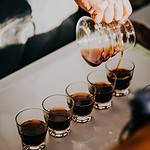Affiliate disclosure: We are reader-supported. This means that we may earn a commission if you buy an item using one of the links. For our reviews, we purchase products ourselves and review them independently. Read more about our methodology.
Summary of Differences
The AeroPress and a pour-over coffee maker are two excellent choices for brewing coffee. The main differences are taste profiles, uses, and size variety.
You can use AeroPress to make espresso-style drinks, coffee, and cold brew. It’s known for its bold, decadent flavor. It comes in two models. Both models make either one to three espresso-sized servings or one coffee-sized serving.
A pour-over coffee maker comes in a variety of sizes and materials. Some popular brands of pour-over coffee makers include Hario, Chemex, and Kalita, though there are many options on the market. Folks love pour-over coffee makers because they make a smooth and clean brew.
| AeroPress | Pour-over | |
|---|---|---|
| Prices | $39.95 to $49.95 (a larger model priced at $79.95 is coming out soon) | $8 to $50, with high-end models above $100 |
| Supplies needed | Paper disc filters or reusable filter | Paper filters or reusable filter |
| Grind size | Fine or extra fine grind | Medium-coarse grind |
| Sizes offered |
|
Single-cup to multi-cup |
| Other uses | Brewing tea | N/A |
| Cleaning | Top rack dishwasher-safe (but rinsing is sufficient for daily use) | Hand wash or dishwasher safe depending on model |
| Materials | Plastic and rubber | Glass, ceramic, metal, or other styles |
| Great for… |
|
|
Brewing Differences
The AeroPress and pour-over coffee makers brew coffee using different methods. With an AeroPress, you submerge coffee grounds in water and press the water through a filter to get coffee.
The AeroPress is known for the rich, bold flavor of the coffee it makes. It can produce espresso-style brews, coffee, and cold brew, making it a versatile coffee maker. It’s quick to brew, taking about two to three minutes from start to finish. We also think it’s accessible to people new to experimenting with different coffee brewing methods. It’s simple to use and even simpler to clean.
The AeroPress is made and marketed by one company, though there are similar products on the market. The AeroPress comes in two models: the original model and the Go travel model. All models are made from plastic and rubber. The company plans to release an extra-large version, which is twice the size of the current models, in the near future.
As their name says, pour-over coffee makers use a pour-over method of brewing. You place coffee grounds in a filter (usually paper) that sits in a funnel. You pour hot water over the grounds, just enough to cover them. This is called blooming the coffee, and it lets gases escape from the beans and improves the taste of your coffee. After the grounds bloom, you pour water over the remaining grounds in a circular or back-and-forth motion to wet all the coffee grounds. The water then drips through the filter into a mug or carafe.
People love pour-over because of the super smooth, clean taste it produces. While there is some art to mastering pour-over, it’s worth the effort. Pour-over coffee makers are also easy to clean.
There are many types of pour-over coffee makers. Some sit on top of a coffee mug and make one cup. There are carafe-style that can brew ten or more cups. Pour-over coffee makers come in glass, ceramic, metal, or other materials.
Grind Size
An AeroPress uses a fine to extra fine grind, depending on your preference (we prefer a fine grind). This grind size is closer to what you’d use to make an espresso. As such, the AeroPress can make espresso-style drinks. Pour-over coffee makers generally use a medium coarse grind.
Cleaning
Both AeroPress and pour-over coffee makers are easy to clean. While the AeroPress is dishwasher safe (top-rack only), you don’t need to run it through the dishwasher every time you use it. You can unscrew the filter cap, press the coffee grounds into the trash or compost bin, toss out the paper filter, and rinse the AeroPress. Because the end of the plunger is rubber, it squeegees the inside of the AeroPress clean.
AeroPress recommends occasionally removing the rubber seal from the plunger and washing it with hot soapy water to preserve its lifespan. You can clean the inside of the AeroPress with white vinegar and water if it gets sticky.
Pour-over coffee makers are similarly easy to clean. If you have one that perches on top of a mug, you can dispose of the coffee grounds and filter and rinse the pour-over coffee maker. You can handwash it as needed.
Some pour-over styles may be dishwasher-safe, especially the ceramic and glass kinds. Make sure to check the manufacturer’s instructions. If you have a carafe-style one, swirling hot soapy water in the carafe is sufficient for daily cleaning.
Alternative Uses
You can use AeroPress to make coffee, espresso-style drinks, cold brew drinks, and tea. For tea, you need to use the inverted method of brewing. We cover that method in our AeroPress brew guide.
There’s a higher chance of spilling hot water when you use the inverted method, so proceed with caution if you choose to brew that way. We generally prefer making our tea in a teapot or with a teabag, but the AeroPress works well in a pinch or if you’re traveling or camping.
While you can make tea in a pour-over coffee maker, we don’t recommend it as you need to use more tea leaves than you need for steeping. Pour-over coffee makers don’t have any other uses that we would recommend. That said, they are very excellent at making coffee. The “lack” of versatility shouldn’t deter you from buying one.
Price
The AeroPress costs $49.95 for the original model and $39.95 for the Go travel model. AeroPress is releasing an extra-large version, costing $79.95, in the future.
Pour-over coffee makers run the gamut in terms of prices. You can buy a single-cup ceramic one for as cheap as $8 or a hand-blown glass carafe-style one for $130. Some popular brands of pour-over coffee makers include Chemex, Hario, and Kalita.
Which One Do We Use?
We have an AeroPress and multiple types of pour-over coffee makers at home. We use both types at home regularly. We have a Chemex, which is carafe style, and two single-serve pour-overs (metal and ceramic).
I typically prefer pour-over because I love the remarkably smooth, clean, and light taste. The AeroPress produces a much richer, bolder flavor, which is not my preference. However, I like to use AeroPress to make cold brew as it has a similar taste profile to pour-over.
That said, it’s really a matter of taste preference because they both make great coffee. If I’m traveling, I’ll take the AeroPress with me as it’s the perfect portable coffee maker, so I don’t have to worry about whether the place I’m staying has a high-quality coffee maker.






